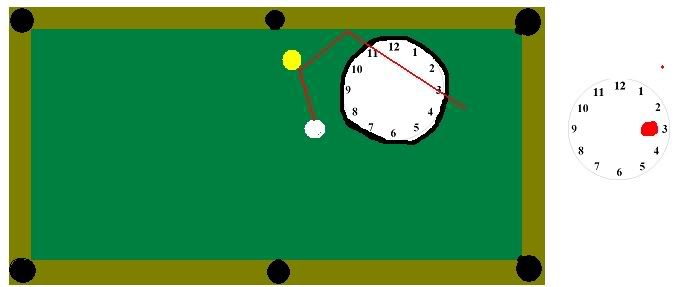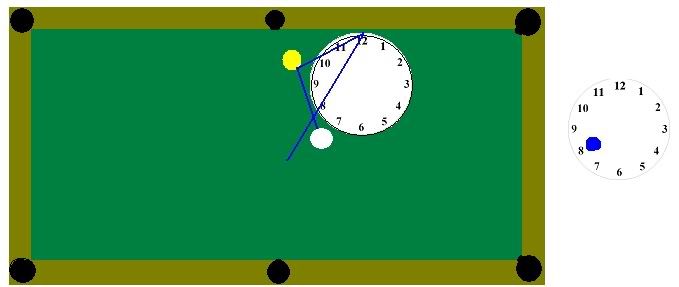You are using an out of date browser. It may not display this or other websites correctly.
You should upgrade or use an alternative browser.
You should upgrade or use an alternative browser.
which english to use
- Thread starter Gutz
- Start date
pooltchr said:Here's a simple rule.
Whichever side you strike the cue ball on, that's the direction it will go, off the rail, relative to the natural rebound angle.
Steve
Yes, if want the cue ball to deflect left of the rail, then hit it on the left side. I think when you contact a object ball first, the deflection switches, so hit the right side to make the object ball go left, but the cue ball will continue to go right. This is called "throw" it will actually throw the object ball the direction the cue ball is spining, it some pretty interesting stuff, try experimenting with it!
Here is a good site of videos that will help, check it out!: http://www.engr.colostate.edu/~dga/pool/normal_videos/index.html
Last edited:
Secaucus Fats
Banned
Gutz said:Does anyone have a method to remember how the cue ball will come off a rail when english has been applied? Its kind of a confusing question but I have to ask.
Effects of english on the cue ball after it contacts a rail:
"Natural" or "Running" english will:
* Add speed to the cue ball after it contacts the rail.
* Widen the angle after the cue ball contacts the rail.
"Reverse" or "un-natural" english will:
* Take speed off the cue ball after it contacts a rail.
* Narrow or close the angle after the cue ball contacts the rail.
To know which english is natural or reverse, draw an imaginary line going through the center of the cue ball straight to the other side of the table. If you are shooting to the left of this imaginary line then left english is "natural" or "running english", and right english is "reverse" or "un-natural" english. If you are shooting to the right of the line then right english is "natural" or "running" english, and left english is "reverse" or "un-natural" english.
If you PM me with your e-mail address I will send you an article that I wrote on the subject of english. It is too large to attach here.
Fats
How I remembered what English to use
I had posted this on another board a little while ago, but this may help you a bit. Now know that the angles are NOT exact. But its a guide to help a beginer remember a little bit easier. The system works better when the angles are closer to 45 degrees and not as well on thin cuts.
But here it is hope it helps!
Well I just wanted to post up how I remembered what english to use on shots to get position. It may help some of the beginners. I came up with this a few years ago because I would always ask "what english do I use to get here?". Since I am a visual learner, I came up with this general guide to help me.
I look at the cue ball as a clock face. Then I visualize that same clock face to the table where I am shooting at. So lets say that I put some top right english (about 3 o clock on the clock face) Then it should end up about 3 o clock on the table also.
Here are some pictures to help visualize what I am describing.
(Now please remember the angles that I am demonstrating are not the exact rebound angles. But approximations)
This first one is a shot with right english

This one is a shot with bottom left (8 o clockish)

This last one is with straight in shots with 3 different types of english. (on this shot you probably cant get the ball to go to the 9 or 3 o clock postions)

Again this is just how I used to remember what english to put on a ball to get shape. It doesnt take into consideration how hard you hit the ball also. This is all with medium stroke. Let me know what you all think and if its worth it to help people understand!
Vic
I had posted this on another board a little while ago, but this may help you a bit. Now know that the angles are NOT exact. But its a guide to help a beginer remember a little bit easier. The system works better when the angles are closer to 45 degrees and not as well on thin cuts.
But here it is hope it helps!
Well I just wanted to post up how I remembered what english to use on shots to get position. It may help some of the beginners. I came up with this a few years ago because I would always ask "what english do I use to get here?". Since I am a visual learner, I came up with this general guide to help me.
I look at the cue ball as a clock face. Then I visualize that same clock face to the table where I am shooting at. So lets say that I put some top right english (about 3 o clock on the clock face) Then it should end up about 3 o clock on the table also.
Here are some pictures to help visualize what I am describing.
(Now please remember the angles that I am demonstrating are not the exact rebound angles. But approximations)
This first one is a shot with right english

This one is a shot with bottom left (8 o clockish)

This last one is with straight in shots with 3 different types of english. (on this shot you probably cant get the ball to go to the 9 or 3 o clock postions)

Again this is just how I used to remember what english to put on a ball to get shape. It doesnt take into consideration how hard you hit the ball also. This is all with medium stroke. Let me know what you all think and if its worth it to help people understand!
Vic